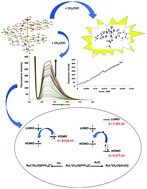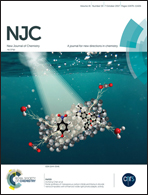A ruthenium(iii) complex derived from N,N′-bis(salicylidene)ethylenediamine as a chemosensor for the selective recognition of acetate and its interaction with cells for bio-imaging: experimental and theoretical studies†
Abstract
A ruthenium(III) complex of N,N′-bis(salicylidene)ethylenediamine (L1) was prepared to give a compound of composition [RuL1(H2O)(PPh3)]PF6, which was examined using spectroscopic methods and single-crystal X-ray diffraction analysis. The geometric analysis was accomplished by DFT studies, which enabled a comparative analysis with related Ru(III) complexes. Sensing studies by means of fluorescence spectroscopy revealed that [RuL1(H2O)(PPh3)]+ performs the selective detection of acetate without interference from the presence of other anions (F−, Cl−, Br−, I−, CN−, ClO4−, NO3−, HSO4−, H2PO4−), with a detection limit of 1.20 × 10−7 M. The stoichiometry of the complex formed between the ruthenium complex and acetate is 1 : 1, as determined by Job's method. Molecular orbital analysis based on DFT calculations revealed that the energy of the orbital, which is responsible for the Photo Electron Transfer (PET) mechanism, is lowered for [RuL1(H2O)(AcO)] when compared to that for [RuL1(H2O)(PPh3)]+, resulting in an enhanced fluorescence intensity after addition of acetate. Furthermore, the recognition of acetate ions with the ruthenium complex in Saccharomyces cerevisiae cells was studied, and the absorption of the substrate (host) within the cells and the subsequent addition of the guest (acetate anion) were carefully examined through fluorescence spectroscopy.



 Please wait while we load your content...
Please wait while we load your content...